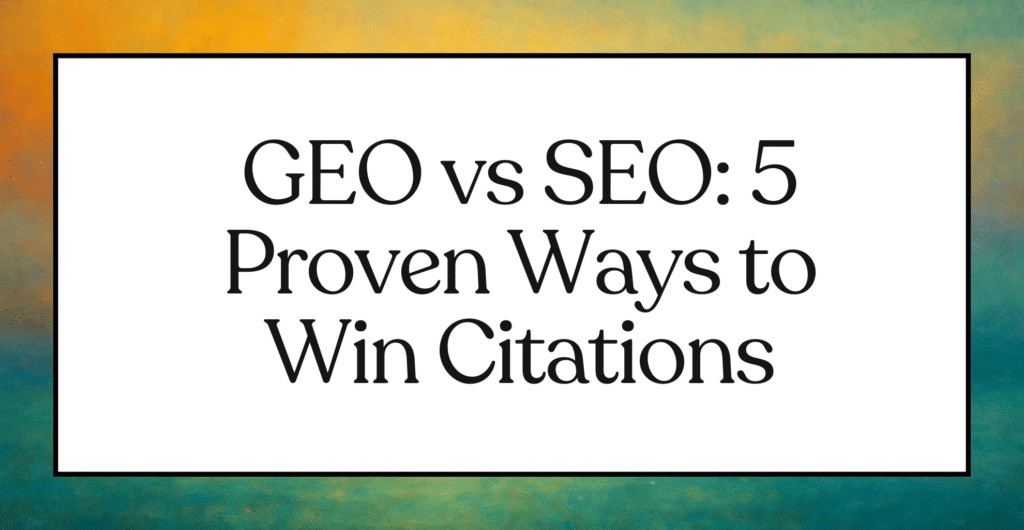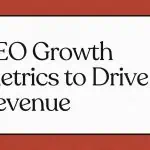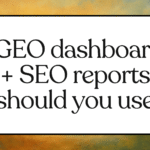Summary
GEO vs SEO explains how SMEs win rankings and AI citations by optimizing entity clarity, structured data consistency, and evidence-backed content for AI Overviews, Bing Copilot, Perplexity, and classic SERPs. The article details five actionable differences in goals, signals, deliverables, measurement, and distribution surfaces plus a metrics spine covering presence rate, citation share, top of snapshot share, inclusion delta vs rank, and assistant referral clicks. It closes with GEO prioritization rules and fast platform moves for Shopify and WordPress, including JSON-LD validation, FAQ blocks, entity pages, single coherent schema, and cluster interlinking.
GEO vs SEO defines how your pages show up in two places that now coexist. Traditional search results still matter for clicks and conversions. AI answer engines assemble responses and cite sources when they decide your page is the most useful proof. SMEs that treat GEO vs SEO as one combined operating system win twice. They earn rankings and earn citations inside AI Overviews, Bing Copilot, Perplexity, and enterprise assistants.
This article answers three things with hard edges. First, the five key differences that separate GEO vs SEO in strategy, signals, and deliverables. Second, how to measure GEO performance, including inclusion in AI answers and assistant citations, alongside classic SERP rankings. Third, when to prioritize GEO tactics over SEO and the fastest platform moves for Shopify and WordPress teams.
Let’s Dig Deep
GEO vs SEO: clear definitions and scope
Search Engine Optimization targets positions and clicks in classic results. Generative Engine Optimization targets presence and citations in AI generated answers. GEO vs SEO is not a rebrand. It refocuses optimization on entity clarity, evidence strength, and machine readability that AI answer engines use to select and justify sources. Google states there is no special markup needed for AI Overviews inclusion. That confirms GEO is not a markup trick. It is content, structure, and reputation tuned to how assistants ground their answers.
Five decisive differences you can act on
- Goal unit
SEO optimizes for a ranked URL and CTR. GEO optimizes for citation in an answer block and the surrounding answer context. The practical output is a page that earns a linked mention inside a synthesized explanation, not only a higher blue link. - Primary signals
SEO emphasizes topical depth, internal linking, authoritative backlinks, and intent coverage. GEO raises the weight of entity clarity, structured data consistency, inline citations to primary sources, and corroboration across reputable third parties. Assistant systems prefer content that is verifiable and conflict free. - Deliverables
SEO deliverables are keyword maps, on-page briefs, link plans, and technical fixes. GEO deliverables add a source evidence plan per page, a schema sanity audit, FAQ style clarifications answering likely conversational follow ups, and a third party corroboration calendar with press, standards, and data sources. - Measurement
SEO measures impressions, rank, CTR, traffic, and conversions. GEO adds inclusion rate by engine, citation count by brand and by page, top of snapshot share, and assistant referral clicks. It tracks whether your brand appears as a cited source and how often. - Distribution surfaces
SEO targets Google Web and Bing organic. GEO targets AI Overviews and AI Mode, Bing Copilot, Perplexity, and enterprise assistants that ingest web content and return grounded responses with links. The surface changes the stakes. Zero click patterns rise, and absence from answer blocks can reduce discoverability even if your page ranks.
How AI engines pick and cite sources
Two design facts anchor GEO. First, Google’s AI features do not require special markup to appear. The best practice set is the same as SEO, yet the bar for clarity and corroboration is stricter. Second, modern assistants publish citations. Perplexity attaches source links to each answer and Copilot’s documentation explains when web search is enabled it grounds with Bing results and cites them. This pushes teams to prefer primary sources, expert quotes with names and credentials, and structured data that matches the visible copy and the product or article facts.
GEO performance metrics that matter
Build a simple metrics spine and track it weekly.
Presence rate
Percent of tracked queries that trigger an AI answer for your market. Segment by engine and country. Rising presence without citations signals a structural gap.
Citation count and share
Total number of times your domain is cited across tracked queries. Share is your citations divided by all citations shown for those queries. Track by page and by entity.
Top of snapshot share
Share of initial visible citations that include your brand for a query. Assistants often display a handful up front. Bias your efforts to win those.
Answer inclusion delta vs. rank
Compare inclusion events to your classic rank. A page that ranks 3 to 5 but wins citation is a GEO asset. A page that ranks 1 but never appears in answers is a GEO liability.
Assistant referral clicks
Use analytics UTM experiments on links you control where possible and triangulate with Search Console position 1 clusters that correlate with queries known to fire AI answers. Record click and lead patterns on days with citations versus without.
Velocity and volatility
Track day by day citation volatility. Sudden drops often map to content conflicts, stale facts, or competitor updates with fresher evidence.
Tooling to track AI answers and citations
Use a mix of productized trackers and manual sampling.
Trackers
ZipTie, Authoritas, SE Ranking, and Otterly monitor inclusion and citations across AI Overviews, Perplexity, and Copilot. They surface query sets, country level checks, and competitive citation share. Pair with manual checks in Perplexity to confirm title-URL matching and context.
Manual baselines
Create a 200 to 400 query list that represents your funnel. Include head, midtail, and questions that imply commercial evaluation. For each query run Perplexity and Copilot in clean sessions weekly and log inclusion.
Search Console pivots
AI Overviews clicks and impressions are counted under Web totals. Use position 1 filters and query clusters that you know trigger AI answers to estimate the overlap. Annotate dates of Google AI updates and engine rollouts to track metric shifts.
Evidence notebook
For each cornerstone page, maintain a short list of primary sources you quote or paraphrase with URLs and ISO dates. Assistants award content that cites and reconciles the best available evidence.
When GEO outranks SEO for SMEs
Prioritize GEO when any of these hold.
- Zero click heavy questions
Informational and how to queries with clear definitions and steps tend to trigger answer blocks. If the query fires an answer most of the time, treat GEO as the primary surface. - Category comparisons with safety sensitivity
Finance, health, legal, and regulated verticals have higher evidence thresholds. Strong citations into AI answers can out-return a raw position gain. - Emergent or fast changing topics
Assistants prefer fresh, reconciled data. If your category shifts monthly, the GEO evidence plan with dated sources is the fastest path to visibility. - Assistant-first audiences
Teams using Copilot, Gemini, or Perplexity at work will not click through as often. Winning citations secures mindshare where research happens.
Shopify quick wins for GEO inclusion
Treat Shopify as a content and data product.
- Validate theme structured data
Most modern themes expose JSON-LD via liquid filters like{{ product | structured_data }}. Confirm Product, Offer, Review, and Article schemas validate cleanly. Run Google Rich Results Test and fix warnings. - Add clarifying FAQs on key templates
Implement an FAQ pattern on product and category pages that answers decision blockers and definitions. Assistants often pull short, sourced clarifications that match long tail phrasing. - Publish entity home
Create an Organization page with legal name, sameAs links, founders or leadership, and postal and local phone data. Ensure it matches your footer and Contact page. This stabilizes entity resolution. - Article schema for guides
Shopify blogs should ship Article schema withheadline,datePublished,dateModified,author.name, andaboutmapped to the product or category entity. - Price and availability freshness
Outdated price or availability drifts trigger assistant conflicts. Ensure dynamic fields in structured data mirror the rendered price and stock. - Image alt texts
Add at least two image alt texts per core page that include GEO vs SEO variants when relevant to your topic pages and guides. For commerce pages, use descriptive product phrases.
Alt text example 1: GEO vs SEO differences matrix for SMEs
Alt text example 2: GEO vs SEO performance metrics dashboard mock
WordPress quick wins for GEO inclusion
Use one schema system and remove duplicates.
- Pick a schema plugin and stick to it
Yoast or Rank Math can generate a coherent graph. Do not run multiple plugins that overlap. Use plugin compatibility settings to remove duplicate output from themes. - Complete Organization and Person graphs
Fill site level Organization attributes with logo, sameAs profiles, and contact options. For authors, ensure Person nodes carry name, job title, and profile links that match visible bios. - Add FAQ and HowTo blocks where appropriate
Use built in blocks to structure Q&A and step content for high intent pages. Keep steps short and cite a primary source when the step depends on a standard. - Update dates and show them
Assistants prefer current material. UsedateModifiedand show an updated date on page when you revise stats. - Cluster and interlink
Create content clusters around entities rather than only keywords. Use hub pages that summarize, cite, and link into specific deep pages.
Vector search and clusters for GEO gains
Vector search moves retrieval from exact words toward meaning. That matters in two ways. First, assistants find and rank sources that best match the concept. Second, your own site search and knowledge hubs benefit from embeddings that group related content. Build clusters that reflect the way a person thinks about a problem, not only how they type it. Use entity links, schema about, and consistent naming to make relationships explicit. If you run an internal search or recommendations feature, modern managed vector services can index your catalog and articles. That improves your own UX and gives your team a testing ground for semantic relevance that aligns with how assistants retrieve.
Africa notes: rollout, constraints, wins
AI answer features expanded to South Africa, Nigeria, Kenya, and many other countries during 2024 and 2025. Google announced AI Overviews availability in over 200 countries and more than 40 languages. Separate to AI Overviews, Google launched AI Mode in multiple African markets in August 2025. Microsoft Copilot lists broad market availability, while Perplexity operates globally and publishes citations consistently.
Constraints remain. Coverage is uneven by country, device, and language. Connectivity and cost shape adoption patterns. The upside is strong. Regional reports show rapid AI uptake in Nigeria, Egypt, South Africa, and Kenya. Local agencies can partner with SMEs to build citation ready guides anchored in national standards, local pricing, and real supplier data. Those pages tend to win citations faster because assistants favor clear local facts over generic advice.
Implementation checklist and pitfalls
Checklist
- Define a 200 to 400 query set per country that maps to your funnel
- Measure presence rate, citation count, top of snapshot share, and assistant referral clicks weekly
- Stabilize entity data: Organization, Person, Product, and Article schema that matches visible copy
- Add short citations to primary sources with ISO dates inside your content
- Publish FAQ sections that answer follow ups assistants already show in related questions
- For Shopify, confirm JSON-LD output via theme filters and fix price and availability parity
- For WordPress, run one schema plugin, clean duplicates, and complete Organization and author graphs
- Build topical clusters with consistent entity naming and internal links
- Maintain an evidence notebook per cornerstone page with sources and last audit date
- Annotate analytics with AI feature rollouts and compare GEO vs SEO movements by week
Pitfalls
- • Chasing markup tricks. Assistants reward clarity and evidence, not hidden tags
• Conflicting facts between your schema and rendered copy. Assistants detect mismatches
• Ignoring volatility. Citation share can swing daily after competitor updates
• Treating GEO vs SEO as either or. Hybrid execution compounds results
• Skipping local context. African SMEs that cite local regulations, payment methods, and delivery realities gain trust and citations
Recommendations
Operational plan for SMEs and agencies
- Ship a GEO evidence layer with every brief. Require two recent primary sources with ISO dates per key claim
- Set weekly GEO reviews. Track inclusion rate, citation share by page, and position 1 clusters in Search Console that match AI answer queries
- Standardize platform moves. On Shopify, fix JSON-LD, FAQ, and entity pages. On WordPress, complete Organization and author graphs and remove schema duplicates
- Build and maintain clusters. Align navigation and internal links to entities, not only keywords
- Expand region specific content. Publish pages with local suppliers, delivery costs, taxes, and payment options
- Document change logs. Record updates with dates. Assistants prefer pages that show when facts were last checked
Prioritization logic
- If a query triggers an AI answer more than half the time and your brand is absent, prioritize GEO for that query set
- If your pages rank but never appear in answers, add citations, clarify entities, and add FAQ segments before chasing more links
- If your category publishes new specs or prices monthly, schedule monthly audits to keep numbers current with ISO dated sources
- If your audience uses assistants at work, add Perplexity and Copilot checks to your weekly sample
Our Take
Adopt GEO vs SEO as one system and run the checklist for eight weeks. Expect movement in presence rate and citation share first, then conversions from assistant referrals. Keep your evidence fresh, your entities consistent, and your clusters tight.
Sources
AI features and your website, Google Search Central, 2025-06-19 – https://developers.google.com/search/docs/appearance/ai-features
GEO: Generative Engine Optimization, Princeton University, 2023-11-16 – https://collaborate.princeton.edu/en/publications/geo-generative-engine-optimization/
How does Perplexity work, Perplexity Help Center, 2025-08-01 – https://www.perplexity.ai/help-center/en/articles/10352895-how-does-perplexity-work
Data, privacy, and security for web search in Microsoft 365 Copilot, Microsoft Learn, 2025-09-12 – https://learn.microsoft.com/en-us/copilot/microsoft-365/manage-public-web-access
Knowledge sources summary, Microsoft Copilot Studio, 2025-10-12 – https://learn.microsoft.com/en-us/microsoft-copilot-studio/knowledge-copilot-studio
Google explains next generation of AI search, Search Engine Journal, 2025-10-14 – https://www.searchenginejournal.com/google-explains-next-generation-of-ai-search/558206/
AI Overviews are now available in over 200 countries, Google The Keyword, 2025-05-13 – https://blog.google/products/search/ai-overview-expansion-may-2025-update/
Google’s AI search summaries expand to 100+ countries, The Verge, 2024-10-28 – https://www.theverge.com/2024/10/28/24281860/google-ai-search-summaries-expand-more-countries
Google brings AI answers to new countries, Reuters, 2024-08-15 – https://www.reuters.com/technology/artificial-intelligence/google-brings-ai-answers-search-new-countries-2024-08-15/
Google AI Overviews reach 1.5B users monthly, The Verge, 2025-04-24 – https://www.theverge.com/news/655930/google-q1-2025-earnings
Italian publishers file complaint over AI Overviews, The Guardian, 2025-10-16 – https://www.theguardian.com/technology/2025/oct/16/google-ai-overviews-italian-news-publishers-demand-investigation
Antitrust complaint over AI Overviews, Reuters, 2025-07-04 – https://www.reuters.com/legal/litigation/googles-ai-overviews-hit-by-eu-antitrust-complaint-independent-publishers-2025-07-04/
Inside the web infrastructure revolt over AI Overviews, Ars Technica, 2025-10-17 – https://arstechnica.com/ai/2025/10/inside-the-web-infrastructure-revolt-over-googles-ai-overviews/
Penske sues Google over AI Overviews, Reuters, 2025-09-14 – https://www.reuters.com/sustainability/boards-policy-regulation/rolling-stone-billboard-owner-penske-sues-google-over-ai-overviews-2025-09-14/
The shift to semantic SEO: what vectors mean, Search Engine Land, 2025-02-28 – https://searchengineland.com/the-shift-to-semantic-seo-what-vectors-mean-for-your-strategy-452766
Q&A
Q: What is GEO vs SEO in modern search and AI answer engines
A: SEO targets ranked URLs and CTR, while GEO targets inclusion and citations inside AI answers using entity clarity, corroborated sources, and machine readable structure.
Q: What are the five decisive GEO vs SEO differences
A: Goal unit, primary signals, deliverables, measurement, and distribution surfaces, with GEO emphasizing citations, evidence plans, schema sanity, assistant metrics, and AI answer surfaces.
Q: How do you measure GEO performance for SMEs
A: Track presence rate, citation count and share, top of snapshot share, inclusion delta vs rank, assistant referral clicks, and day to day volatility.
Q: What quick wins improve GEO inclusion on Shopify and WordPress
A: Validate JSON-LD, add clarifying FAQs, publish Organization entity pages, keep prices and availability fresh, use one schema plugin on WordPress, complete Organization and Person graphs, add FAQ and HowTo blocks, update dates, and cluster content by entities.









